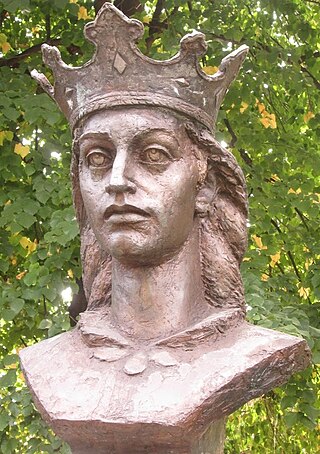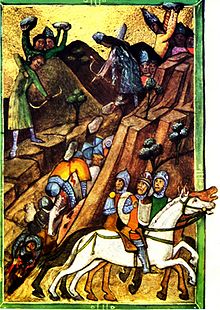
Wallachia or Walachia is a historical and geographical region of modern-day Romania. It is situated north of the Lower Danube and south of the Southern Carpathians. Wallachia was traditionally divided into two sections, Muntenia and Oltenia. Dobruja could sometimes be considered a third section due to its proximity and brief rule over it. Wallachia as a whole is sometimes referred to as Muntenia through identification with the larger of the two traditional sections.

Basarab I, also known as Basarab the Founder, was a voivode and later the first independent ruler of Wallachia who lived in the first half of the 14th century. Many details of his life are uncertain. Although his name is of Turkic origin, 14th-century sources unanimously state that he was a Vlach (Romanian). According to two popular theories, Basarab either came into power between 1304 and 1324 by dethroning or peacefully succeeding the legendary founder of Wallachia, Radu Negru, or in 1310 by succeeding his father, Thocomerius.

Stephen III, commonly known as Stephen the Great ; died on 2 July 1504), was Voivode of Moldavia from 1457 to 1504. He was the son of and co-ruler with Bogdan II, who was murdered in 1451 in a conspiracy organized by his brother and Stephen's uncle Peter III Aaron, who took the throne. Stephen fled to Hungary, and later to Wallachia; with the support of Vlad III Țepeș, Voivode of Wallachia, he returned to Moldavia, forcing Aaron to seek refuge in Poland in the summer of 1457. Teoctist I, Metropolitan of Moldavia, anointed Stephen prince. He attacked Poland and prevented Casimir IV Jagiellon, King of Poland, from supporting Peter Aaron, but eventually acknowledged Casimir's suzerainty in 1459.

Radu III of Wallachia, commonly called Radu the Handsome, Radu the Fair, or Radu the Beautiful, was the younger brother of Vlad the Impaler and prince of the principality of Wallachia. They were both sons of Vlad II Dracul and his wife, Princess Cneajna of Moldavia. In addition to Vlad III, Radu also had two older siblings, Mircea II and Vlad Călugărul, both of whom would also briefly rule Wallachia.

Șerban Cantacuzino, was a Prince of Wallachia between 1678 and 1688.

Vlad II, also known as Vlad Dracul or Vlad the Dragon, was Voivode of Wallachia from 1436 to 1442, and again from 1443 to 1447. He is internationally known as the father of Vlad the Impaler, or Dracula. Born an illegitimate son of Mircea I of Wallachia, he spent his youth at the court of Sigismund of Luxembourg, who made him a member of the Order of the Dragon in 1431. Sigismund also recognized him as the lawful Voivode of Wallachia, allowing him to settle in nearby Transylvania. Vlad could not assert his claim during the life of his half-brother, Alexander I Aldea, who acknowledged the suzerainty of the Ottoman Sultan, Murad II.

Vlad III, commonly known as Vlad the Impaler or Vlad Dracula, was Voivode of Wallachia three times between 1448 and his death in 1476/77. He is often considered one of the most important rulers in Wallachian history and a national hero of Romania.

Dan II cel Viteaz was a voivode of the principality of Wallachia, ruling an extraordinary five times, and succeeded four times by Radu II Chelul, his rival for the throne. Of those five periods on the throne of Wallachia, four were within a period of only seven years.
Basarab IV cel Tânăr, also known as Țepeluș, son of Basarab II, and grandson of Dan II (1422-1431) was 4 times the voivode of the principality of Wallachia between 1474 and 1482: from Oct to Dec 1474, from Jan 1478 to June 1480, from Nov 1480 to before July 1481, and again from Aug 1481 to July 1482.

The House of Cantacuzino is a Romanian aristocratic family of Greek origin. The family gave a number of princes to Wallachia and Moldavia, and it claimed descent from a branch of the Byzantine Kantakouzenos family, specifically from Byzantine Emperor John VI Kantakouzenos. After the Russo-Ottoman War of 1710–11, a lateral branch of the family settled in Russia, receiving the princely status. In 1944, Prince Ștefan Cantacuzino settled in Sweden, where his descendants form part of the unintroduced nobility of that country.

Michael the Brave, born as Mihai Pătrașcu, was the Prince of Wallachia, Prince of Moldavia (1600) and de facto ruler of Transylvania (1599–1600). He is considered one of Romania's greatest national heroes. Since the 19th century, Michael the Brave has been regarded by Romanian nationalists as a symbol of Romanian unity, as his reign marked the first time all principalities inhabited by Romanians were under the same ruler.

The Battle of Vaslui was fought on 10 January 1475, between Stephen III of Moldavia and the Ottoman governor of Rumelia, Hadım Suleiman Pasha. The battle took place at Podul Înalt, near the town of Vaslui, in Moldavia. The Ottoman troops numbered up to 120,000, facing about 40,000 Moldavian troops, plus smaller numbers of allied and mercenary troops.

Vlad VI of Wallachia was the voivode (prince) who ruled Wallachia between June 1530 and September 1532. He has been historically referenced as Vlad Înecatul, as a description of the manner of his death.

The House of Basarab was a ruling family of Cuman origin, which had an important role in the establishing of the Principality of Wallachia, giving the country its first line of Princes, one closely related with the Mușatin rulers of Moldavia. Its status as a dynasty is rendered problematic by the official elective system, which implied that male members of the same family, including illegitimate offspring, were chosen to rule by a council of boyars. After the rule of Alexandru I Aldea, the house was split by the conflict between the Dănești and the Drăculești, both of which claimed legitimacy. Several late rulers of the Craiovești claimed direct descent from the House after its eventual demise, including Neagoe Basarab, Matei Basarab, Constantin Șerban, Șerban Cantacuzino, and Constantin Brâncoveanu.
The Early Modern Times in Romania started after the death of Michael the Brave, who ruled in a personal union, Wallachia, Transylvania, and Moldavia – three principalities in the lands that now form Romania – for three months, in 1600. The three principalities were subjected to the Ottoman Empire, and paid a yearly tribute to the Ottoman Sultans, but they preserved their internal autonomy. In contrast, Dobruja and the Banat were fully incorporated into the Ottoman Empire.
The House of Drăculești were one of two major rival lines of Wallachian voivodes of the House of Basarab, the other being the House of Dănești. These lines were in constant contest for the throne from the late fourteenth to the early sixteenth centuries. Descendants of the line of Drăculești would eventually come to dominate the principality, until its common rule with Transylvania and Moldavia by Mihai Viteazul in 1600.
Radu of Afumați was Voivode (Prince) of Wallachia between January 1522 and January 1529. He began his reign with a victory against Mehmed-bey, a pretender to Wallachia's throne. From 1522 to 1525 he battled the Turks, who supported Vladislav III and Radu Bădica, both claimants of the throne. The inscription on his tombstone lists 20 battles. He was killed by decapitation on 2 January 1529 near Râmnicu Vâlcea, at Cetățuia Church. He was later buried in the Curtea de Argeș Cathedral.

Diicul or Dicul Buicescul, also known as Diicu Buicescu and Diicu din Epotești, was a Wallachian statesman, noted as the designated heir of Prince Matei Basarab. A commoner on his father's side, he belonged to the boyardom of Oltenia through his mother's family. His political rise began when Matei, his maternal relative, seized the throne. Diicul alternated civilian offices and command postings in the Wallachian military forces, culminating with his appointment as Spatharios in January 1645. His main military involvement came during the wars opposing Wallachia and the Principality of Transylvania to Vasile Lupu's Moldavia. He saw action during the 1650 invasion of Moldavia, resulting in Gheorghe Ștefan's appointment as the puppet Moldavian Prince. In 1653 Buicescul was soundly defeated by Lupu and his Cossack allies, whose invasion of Wallachia was only overturned by Prince Matei's stand at Finta.

The Paharnic was a historical Romanian rank, one of the non-hereditary positions ascribed to the boyar aristocracy in Moldavia and Wallachia. It was the local equivalent of a cup-bearer or cześnik, originally centered on pouring and obtaining wine for the court of Moldavian and Wallachian Princes. With time, it became a major administrative office and, in Wallachia, also had a lesser military function. The retinue of such boyars, usually called Păhărnicei, was in both countries also a private army.



![Battle of Selimbar in 1599, engraving by Georg Keller [de] Battle of Selimbar - Georg Keller, cropped.jpg](http://upload.wikimedia.org/wikipedia/commons/thumb/3/38/Battle_of_%C8%98elimb%C4%83r_-_Georg_Keller%2C_cropped.jpg/250px-Battle_of_%C8%98elimb%C4%83r_-_Georg_Keller%2C_cropped.jpg)





![The saici of Michael the Brave at the Battle of Giurgiu, oil painting by Dimitrie Stiubei [ro] Panou 6.jpg](http://upload.wikimedia.org/wikipedia/commons/thumb/e/e4/Panou_6.jpg/220px-Panou_6.jpg)














